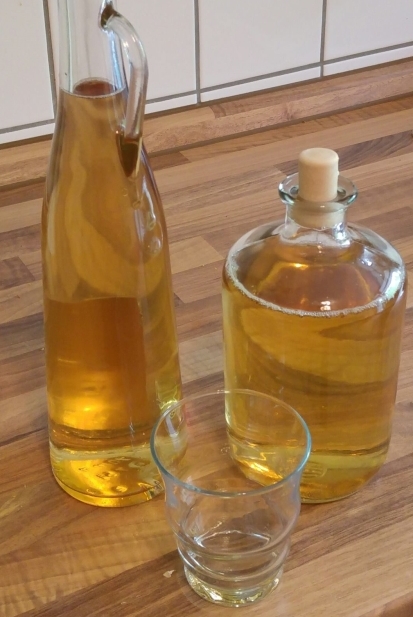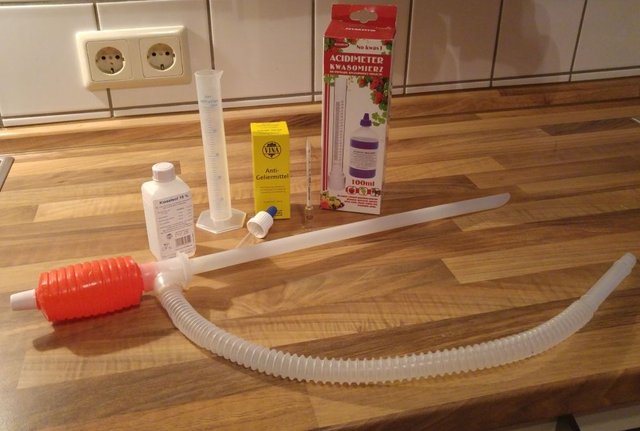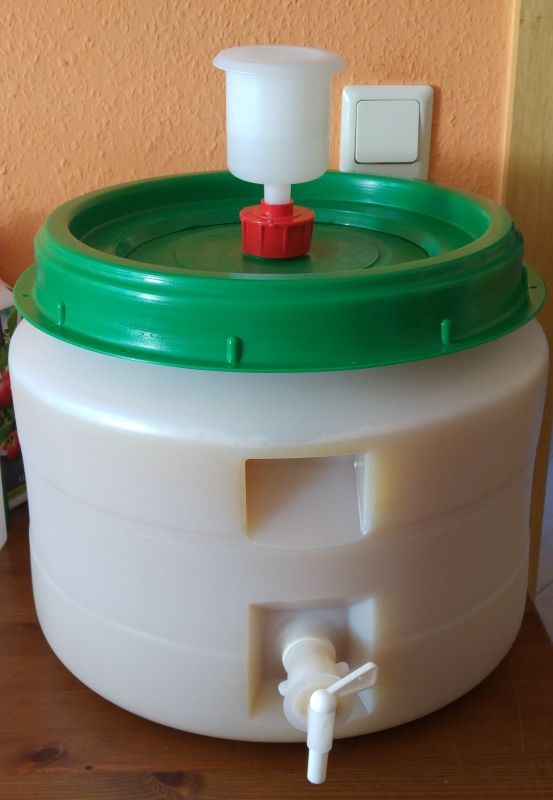Homebrew mead recipe and report (part 1/2)
Heyho Steemit-lovers :)
It's time to share my favorit mead recipe with this wonderful community. I really can recommend making your own mead, it's very satisfying and tastes a lot better and is cheaper than the stuff from the supermarket. If you are interested in brewing your own alcoholc drinks, this guide is a good start. Producing wine (or mead especially) is relatively easy.
I'm not a native english speaker and had some problems translating the names of some of the ingredients and tools. Please bare this in mind and ask me if something sounds strange =)
Story
One of my favorit hobbies are medieval festivals. We have a huge scene in Germany with a lot of events, bands and groups. A lot of people make their own medieval-themed stuff like clothing, tools, furniture, etc. or have something different to provide to their groups.
I'm not talented with needle and thread nor am I good with one's hands. But I like mixing drinks so I thought: why not mix a drink for all the brave warriors and master-tailors? I love mead but many brands are a bit too sweet for my taste. So the idea of a mead with the perfect "sweet spot" was born ;-)
I looked up some tutorials an started my first experiments. After months of fermentation the first 10 liter bottle of mead was ready and it was pretty good. All of my friends liked it, so I had to continue. I improved the recipe and clarified the wine afterwards. So it wasn't only delicious it even looked very beautiful:
It was a good idea to produce outright 30 liters ;-)
Now, with some experience, I tested a new recipe with a more expensive honey direct from a beekeeper in our region. This mead isn't ready yet but it only needs filtration/clarification.
Fourth charge
Because of the increased need I started a new charge with 30 liters. This time I used honey from a supermarket to lower the costs. In the following I will describe the recipe and every step I did to start the fermentation. Maybe this helps someone to brew his own delicious mead :)
Preparation
There are two very important hints if you like to start your own brew:
- Be patient
- Keep everything clean
Equipment & ingredients
You will need the following equipment...:
- fermenter (fermentation barrel with 30 liter) with a bung (airlock which allows the air to escape but forbids air from the outside to enter the vessel)
- second fermenter or barrel for the cuttings
- kitchen scales
- milligram scale
- normal beaker
- measuring cylinder for 50ml
- acidimeter + indicator fluid
- vinometer for measuring the alcohol value
- wine siphon
- funnel
- pipette
- bottles or canisters to store the finished mead
...and the following ingredients:
- 5.25 kilos of honey (you will need to refill more later, so buy some additional glasses of honey)
- 9.45 liters of destilled water
- 9 liters of applejuice (organic, naturally cloudy)
- 9 apples (russet apples are a good choice. It's important to take organic apples, pesticides don't belong into wine!)
- 2.6 g of tanin
- 20 ml of antigel (is this the correct english translation?)
- 10.4 g of yeast feeding salt
- 5 g of yeast
- citric acid (you may need something between 5 and 20 g)
- lactic acid 80% (you will need something between 50 and 100 ml)
- isopropyl (buy 500 ml or more)
- silica sol 15% for the filtration
- potassium metabisulfite for sulphuration (you will need that often, buy 100g+)
I recommend yeast for sherry or port wine but you can also get normal wine yeast. Its easier to use dry yeast. If you have a liquid you need to set up a "fermentation starter". I never did this before so you should do some research on your own.
Disinfection
You must clean your barrel and equipment very well. You can clean it with mild soap and warm water. After that flush everything out with water until their is no soap, dirt or smell left. After that you should desinfect your tools and vessels.
To do so mix a disinfection fluid. But BE CAREFUL! It has a very keen smell and attacks the mucous membranes. Be cautious to get nothing in your eyes.
Okay master-chemists, lets mix:
- 15 g of potassium metabisulfite
- 1 l of hand-hot water
- 4 g of citric acid
and put it in your barrel. Then rinse out your barrel so every part is disinfected. It's a good idea to put all your tools in your barrel and clean them as well. You can reuse the disinfection liquid to clean your supplies and tools (wine siphon, funnel, etc.) manually.
Now you can rinse out your barrel with a bit of isopropyl. That will speed up the drying. Put your barrel and all your stuff in a clean place to drip off. A good tip is to use the baskets in your (empty) dishwasher. This should be a clean place. After some time, when everything is dry, you can start!
Lets make some mead!
Grind all the apples!
You can do everything on your own but it's faster and funnier with an assistant. It's best to start with shredding the apples because that will take a while. Clean your apples well, remove the apple cores and grind the rest. Unless you're Ms./Mr. Universe someone should help you with this task. The apple mash is getting brown fast, cover it until you need it.
After that or parallel you can
Fill the witch's cauldron
Lets do some magic! To pour the honey out of the glasses you can warm them up first. For one glass set your microwave at 360 °C for 30 - 60 seconds. You can put 3 glasses in the microwave at once but then you have to increase the time. It's very important that the honey doesn't get too hot (max. 40 °C).
Now fill the following ingredients as listed into the barrel:
- 5.25 kg of warm honey
- 9.45 l of distilled water (you can use some of this water to flush out the honey pots. Every honey blob is sacred ;-) )
- 10.4 g of yeast feeding salt
- 2.6 g of tanin
Now sway or stir the barrel until the honey has completely desolved. Now add the grinded apples and 9 liters of apple juice. After that you should add around 20 ml of antigel and mix it all again.
If you haven't reached the 25 liter mark yet, you can add some additional distilled water. Throughout the next weeks you will add additional ingredients like sugar and honey so keep at least 5 liters of space in your barrel.
Determine acidity
Before you do that you could start rehydrating the yeast (next headline) because it needs 30 minutes before you can add it to your must.
A tasty mead needs a good balance between acid and sweet. It's possible that your apples and juice had a lot of acid or the opposite. It's best to measure the acidity and then adjust the value with lactic acid and, if necessary, citric acid. To measure the acid value first stir or sway the mead again. Then follow the instructions wich came with your aciometer. Normally you have to fill a sip (often 10 ml) in a small cylinder and add some indicator fluid in small drops (mix it everytime), until the must turns green/blue. Than you can read off the acid value from the scale on the cylinder or consult a table in the manual of the acidometer. Normally 1 ml of used indicator fluid corresponds to an acid amount of 1 gram per liter.
For beginners an acid value of 6.5 g/l is a good target. So there is a high chance that you need to adjust the acid value of your must. To do so, add lactic acid. 1.25 ml of 80% lactic acid increases the acid value of 1 liter wine by 1 gram per liter. You will need to do some math here. It's not recommended to use more than 3.5 ml of lactic acid per liter. If thats still not enough you can do the rest with citric acid. 1 g of citric acid increases the acid value by 1 g/l.
For example: I measured an acid value of 4.1 g/l. To reach 6.5 g/l I needed 2.4 g/l more. To add 1 g/l I would need 1.25 ml of lactic acid. To add 2.4 g/l I need 2.82 ml of lactic acid. I had 26 liters alltogether in my barrel. So thats 2.82 * 26 = 73 ml of lactic acid.
Add the calculated value to your must and give it a good mix.
Rehydrate the yeast
Fill 40 ml of hand-hot water (approx. 30 °C) in a small glass and slowly stir in 5 g of yeast until the yeast is solved. Do it carefully and with love :)
After 30 minutes your yeast is ready. At best you are done with everything else at this point. You shouldn't let the yeast wait much longer.
Start the fermentation
This step is pretty simple: Add your rehydrated yeast to your must and mix it again. Seal the barrel and fill the bung with water so that the air can escape but no air, dirt, dust or fruit flies can enter the barrel.
Then place your barrel in a warm room (19-23 °C is fine). As a rule of thumb you could use: If the human likes the temperature, the mead will like it as well. Now you have to wait. After 24-48 hours the fermentation should start. You will hear bubbling and your whole flat will smell of fermentation. Nice! :D
Wait
Now it's time to wait! I'm going to write a second part where I cover the fermentation process, how to reach the perfect sweetness and how to clear your wine.
I hope this article is interesting or helpflul for you. Please leave any questions and comments, I will answer them asap.



Something I've never had a clear answer two, how much apple juice in the must makes it a cyser instead of mead?
Mhh I never tried cyser so I can only guess...
The ingredients you add later in the fermentation process will dominate the taste. So maybe instead of adding solely honey you add apple juice as well.
But just be careful because adding fruit juice after the fact can cause more fermentation (boom!)
A lot of people do not realize that fruit and raw honey have built in yeast. I'm about to test a batch in fact that will have ZERO extra yeast added. It will be raw honey with organic raisins.
You can search for YT videos on how people "make their own yeast" with just water and raisins/grapes. They are not making anything. The yeast, fungi, are already on the fruit.
The same is true for honey. The fungi are already in it. Therefore, we should be able to put honey, spring water, raisins, and any other fruit we want in a container and have it slowly ferment. Sure, it will not be as fast as usual, but it should work.
On a YT video I watched a couple days ago, a guy was reading from a book written in 1736 that had a mead recipe in it. The recipe specifically said adding yeast was optional. They probably didn't know why back then, but that's because the honey already had yeast.
Part 2 is now online: https://steemit.com/drinking/@thecoach/titel-homebrew-mead-recipe-and-report-part-2-2
Very good post, I like you very much, I follow you
Thanks mate!
I'm going to upload part 2 very soon. Stay tuned!
ok